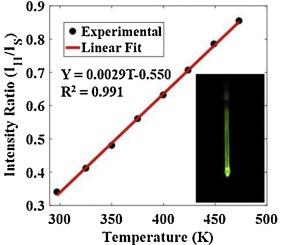Sensors and Actuators A: Physical ( IF 4.1 ) Pub Date : 2020-05-21 , DOI: 10.1016/j.sna.2020.112083 Rahul Kumar , Leonardo Binetti , T. Hien Nguyen , Lourdes S.M. Alwis , Tong Sun , Kenneth T.V. Grattan

|
The thermally coupled green band emission from excited Er3+ ions has been used in the past to create optical thermometers, by doping the material in various types of media, particularly glasses. Glasses are known to be excellent hosts for Er3+ ions: however, high temperatures (>900 K) are usually required for doping these ions into glasses and a non-linear temperature response is often produced. In this work, the frequently encountered drawbacks of glass-based temperature sensors have been addressed by developing a temperature sensor created at a lower temperature (543 K), by dip-coating chemically synthesized upconverting nanoparticles (UCNP – NaYF4:(18%) Yb3+, (2%) Er3+) embedded in polydimethylsiloxane (PDMS) onto the tip of a 1000 μm optical fibre, to create the actual fibre probe. The sensor shows an excellent linear response (R2 = 0.991) over a very useful temperature range of 295 K – 473 K, with a sensitivity of 2.9 × 10-3 K-1, a temperature resolution of ± 2.7 K and response time of ∼ 5 seconds. Additionally, a probe was investigated where a pure upconverting nanoparticle powder was coated on the tip of optical fibre and its spectral and temperature response was obtained (and cross compared with that of UCNP-PDMS composite). The results obtained from the probe development work show that the UCNP-PDMS-coated optical fibre temperature sensor developed offers a better alternative to more conventional Er3+ doped glass-based temperature sensors, in terms of the thermal budget, the synthesis process and the ease of coating, creating as a result, a very linear device response.
中文翻译:

使用比例转换绿色发射的上转换纳米粒子-聚二甲基硅氧烷复合材料进行光纤测温
过去,通过将材料掺杂到各种类型的介质(尤其是玻璃)中,来自激发的Er 3+离子的热耦合绿带发射已用于创建光学温度计。众所周知,玻璃是Er 3+离子的优良宿主:但是,通常需要高温(> 900 K)才能将这些离子掺杂到玻璃中,并且经常会产生非线性温度响应。在这项工作中,通过开发在较低温度(543 K)下创建的温度传感器,通过浸涂化学合成的上转换纳米颗粒(UCNP – NaYF 4:(18%),解决了玻璃基温度传感器经常遇到的缺点。Yb 3+,(2%)Er 3+)嵌入聚二甲基硅氧烷(PDMS)到1000μm光纤的尖端上,以创建实际的光纤探针。该传感器 在非常有用的295 K – 473 K温度范围内显示出出色的线性响应(R 2 = 0.991),灵敏度为2.9×10 -3 K -1,温度分辨率为±2.7 K,响应时间为约5秒钟。另外,研究了一种探针,在该探针上将纯上转换纳米颗粒粉末涂覆在光纤尖端上,并获得了其光谱和温度响应(并与UCNP-PDMS复合材料进行了交叉比较)。探头开发工作获得的结果表明,开发的UCNP-PDMS涂层光纤温度传感器为更常规的Er 3+提供了更好的替代品 掺杂的玻璃基温度传感器,在热预算,合成过程和涂覆的难易程度方面,产生了非常线性的设备响应。











































 京公网安备 11010802027423号
京公网安备 11010802027423号